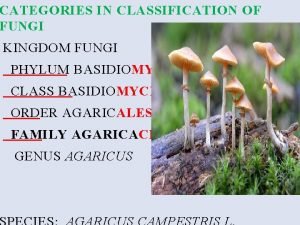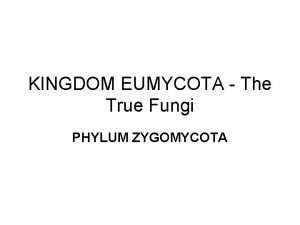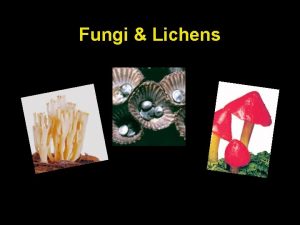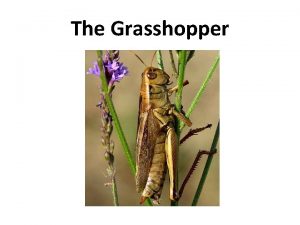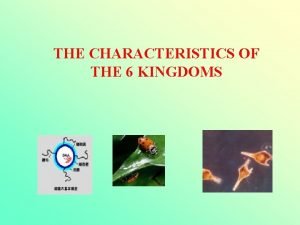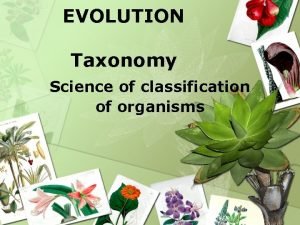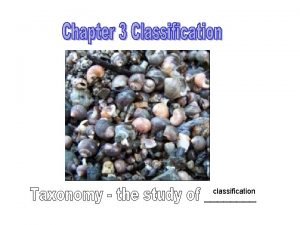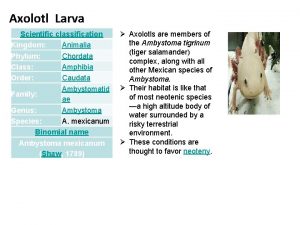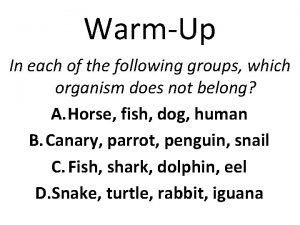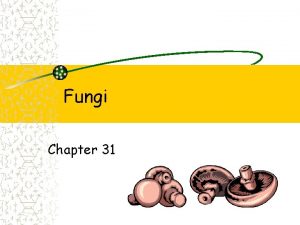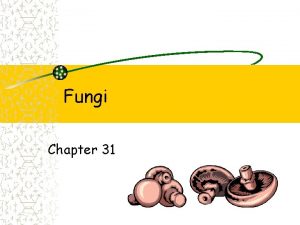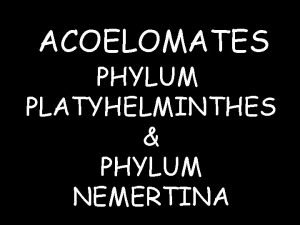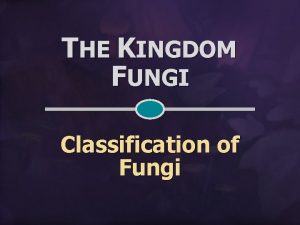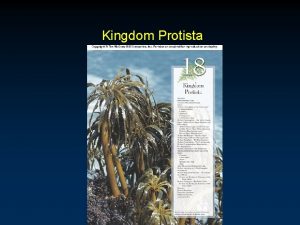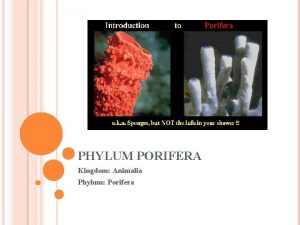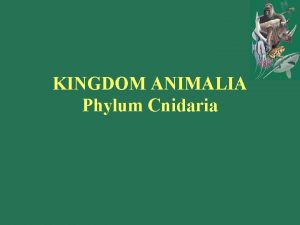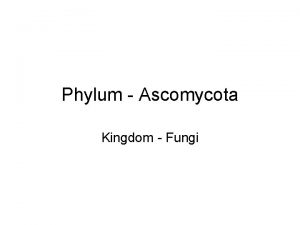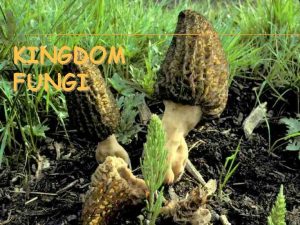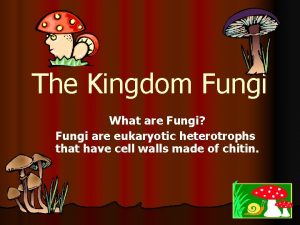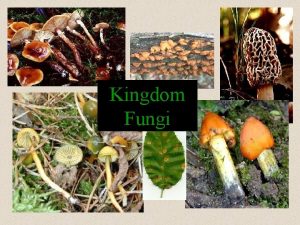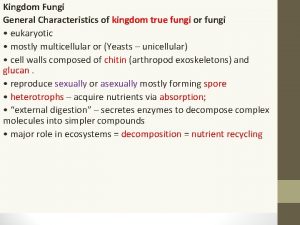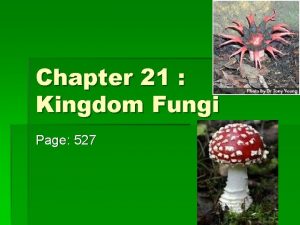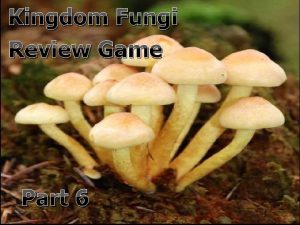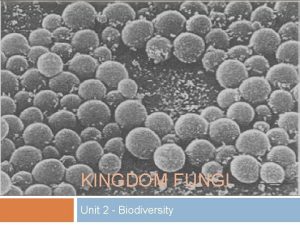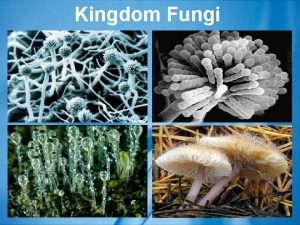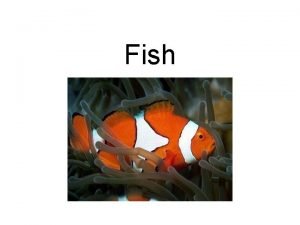CATEGORIES IN CLASSIFICATION OF FUNGI KINGDOM FUNGI PHYLUM


























- Slides: 26

CATEGORIES IN CLASSIFICATION OF FUNGI KINGDOM FUNGI PHYLUM BASIDIO MYCOTA CLASS BASIDIO MYCETES ORDER AGARIC ALES FAMILY AGARICA CEAE GENUS AGARICUS

According to Alexopolus 1996 can classified fungi into 3 phyla depended upon the characteristics of fungi ( Somatic Phase , Sexual And Asexual Spores )

1 - Kingdom: Protista or Protozoa Phylum: Myxomycota Phylum: Plasmodiophoromycota 2 - Kingdom: Straminpilia (Cromista ) Phylum Hyphochytriomycota Phylum Labyrinthulomycota Phylum: Oomycota 3 - Kingdom: True Fungi (Fungi) Phylum: Chytridiomycota Phylum: Zygomycota Phylum: Ascomycota Phylum: Basidiomycota

Kingdom: Protista or Protozoa ( Phylum: Myxomycota) The Latin name Myxomycota comes from the Ancient Greek words μύξα (myxa), which means "mucus", and μύκης (myces), which means "fungus". . Members of this division are commonly referred to as slime molds. Although presently classified as Protozoans, in the Kingdom Protista, slime molds were once thought to be fungi (kingdom Mycetae which includes lower and higher fungi) because they produce spores that are borne in sporangia

a characteristic common to some taxa of fungi. However, the assimilative stage in slime molds is morphologically similar to that of an amoeba. This assimilative stage has been designated a myxamoeba The myxamoeba, as is the case of the amoeba, is a uninucleate, haploid cell which is not enclosed in a rigid cell wall, and ingests its food by means of phagocytosis. In fungi, the assimilative stages are mycelium and yeast, both of which are surrounded by a rigid cell wall and obtain their food by means of absorption. These are some of the reasons why mycologists no longer recognize slime molds as being fungi.

1 - lack cell wall 2 - somatic phase is uninucleate flagellated swarm cell (1 n) or an amoeba is called myxoamoeba (1 n) others multinucleate is called plasmodim a mass ameoboid protoplasm has many nuclei ( multinucleate ) , 2 n cell wall less. 3 -produce spores that are borne in sporangia, 4 - Most of these individuals are saprophyte , and its nutrition phagotrophic.

5 - life cycle: - spores are germinated to form myxamoebae(non flagellated) or swarm cells (flagellated cell). And fused swarm cells or myamoebae sexually to produce zygote (2 N) , zygote germinate forming plasmodium (2 N) During favorable conditions, the plasmodium will migrate and feed for a period of time before being converted to numerous sporangia


Phylum : Plasmodiophoromycota are a group of obligate parasites commonly referred to as endoparasitic slime molds. Has the same characteristic of phylum myxomycota , All members are obligate parasites of algae, fungi, or plants, causing cell enlargement, especially of the roots. They are distinguished by the production of motile cells (zoospores) with two unequal anterior whiplash (flagella)

The best-known examples attack higher plants, causing economically significant diseases such as club-root of brassica (Plasmodiophora brassicae), powdery scab of potato (Spongospora subterranea:

KINGDOM STRAMENOPILA (CHROMISTA) INCLUDES DIATOMS, CHRYSOPHYTES, BROWN ALGAE AND PHYLA OF FUNGAL-LIKE ORGANISMS: PHYLUM 1 HYPHOCHYTRIOMYCOTA PHYLUM 2 LABYRINTHULOMYCOTA PHYLUM 3 OOMYCOTA ITS NAME WAS INTRODUCED BY D. J. PATTERSON IN 1989 BASED ON TINSEL-TYPE FLAGELLUM. TINSEL FLAGELLUM WITH TWO ROWS OF TUBULAR TRIPARTITE HAIRS , PULLS ZOOSPORE THROUGH WATER AND PRESENCE OF FILAMENTOUS THALLUS IN SOME STRAMENOPILES AND FUNGI IS

The individuals of 3 phyla are shared with true fungi in many physiological and morphological characteristics like have cell wall , and somatic phase consist from branched filaments hyphae and their nutrition is Absorption but different from true fungi in forming zoospores and the chemical components of cell wall is cellulose. On the other hand theses individuals also different from protistae (slime molds ) in forming branched hyphae , have cell wall while somatic phase in slime mold (myxoamoeba uninucleate or plasmodium multinucleate ) , cell wall less and its nutrition is phagotrophic in slime molds while absorptive nutrition in stramenopila.


Phylum Oomycota (water molds) Oomycota" means "Egg Fungi" and refers to the large round oogonia, or structures containing the female gametes. has economic importance because it includes water molds (grow on injured tissue but also will grow on the skin and gills of fish ) and downy mildews (parasitic terrestrial plants acts as a pathogen ). They are filamentous which must absorb their food from the surrounding water or soil, or may invade the body of another organism to feed. As such, oomycetes play an important role in the decomposition and recycling of decaying matter. Other parasitic species have caused much human suffering through destruction of crops and fish.


Characteristic of oomycota 1 -have cell walls composed of cellulose and glycan , a diploid dominant lifecycle (2 n). 2 - Somatic Phase : The mycelium is coenocytic and produce septa only to separate the reproductive structures from the assimilative portion of the thallus. 3 - Asexual reproduction is by zoospores that are produced in zoosporangia. The zoospores produced are biflagellated with one flagellum of the whiplash type and the other of the tinsel type. 4 -Sexual reproduction is heterogamous and occurs by direct injection of the male nuclei (=sperms) from the antheridium into the eggs contained in the oogonium .

Class: Oomycetes The characteristics of the class Oomycetes is the same as those of the division. We will examine two representatives in the Oomycota: two orders (Saprolegniales) and (Peronosporales). Saprolegnials is include the largest family saprolegniaceae : ex: Saprolegnia parasatica and Achlya spp.

Saprolegnia is the main genus of water molds responsible for significant fungal infections of freshwater fish and eggs. it likes most water moulds, is both a saprotroph and necrotroph (facultative parasites ). Typically feeding on waste from fish or other dead cells, Saprolegnia has a complex life cycle which includes both sexual and asexual reproduction. Sexual reproduction involves the production of antheridium and oogonium gametangia, which unite for fertilization . The asexual spore of Saprolegnia release motile, primary zoospores . Primary zoospores are active only for a few minutes before they encyst, germinate, and release a secondary zoospore . Secondary zoospores are motile for a longer period of time than primary zoospores then also encysts, before it germinates into a new mycelium,


Perononsporaceae (Downey mildew disease family ) : - refers to any of several types of oomycete microbes that are obligate parasites of plants. Downy mildews exclusively belong to Peronosporaceae. including species of Basidiophora, Bremia, Peronospora, Phytophthora, Plasmopara, Pseudoperonospora, and Sclerospora.

1 - Plasmopara sp. Sporogiophore branched is irregular with short and striaght sterigma 2 - Bremia sp. The ends of sporogiophore is branched many branches like palm and bear 4 sterigma on each of it one sporangium

3 - Peronospora sp. Sporangiophore is branched dichasium and its branches long, curved terminal 4 - Basidiophora sp. spongophore is Simple and sowllen at the top and carries on its surface sporangia based on sterigma 5 -Sclerospora sp. Sporangiophore is thick dendritic shaped branching many branches at the tip and bearing sporangia


Water molds Vs. fungi 1 -water molds have cellulose for their cell walls , while fungi have chitin 2 -water molds have diploid nuclei , whereas fungi have haploid nuclei. 3 - self-motile spores of oomycetes usually have two flagella , while fungal spores have only one. 4 - they both have different metabolic pathways for synthesizing lysine (an essential amino acid ). 5 - number of certain enzymes differ.


 Old kingdom middle kingdom new kingdom
Old kingdom middle kingdom new kingdom Old kingdom middle kingdom new kingdom
Old kingdom middle kingdom new kingdom Youtube egypt
Youtube egypt Capital of egypt during the old kingdom
Capital of egypt during the old kingdom Basidiomycetes
Basidiomycetes Fungi phylum classification
Fungi phylum classification Zygomycetes
Zygomycetes Are protists eukaryotic
Are protists eukaryotic What do kingdom fungi and kingdom plantae share
What do kingdom fungi and kingdom plantae share Fungi domain and kingdom
Fungi domain and kingdom Kingdom phylum genus
Kingdom phylum genus Classification of fungi
Classification of fungi Subphylum of grasshopper
Subphylum of grasshopper Characteristic of animal kingdom
Characteristic of animal kingdom Family genus species order
Family genus species order Kingdom phylum class order
Kingdom phylum class order Genus example
Genus example Pig domain kingdom phylum class
Pig domain kingdom phylum class Horse taxonomy
Horse taxonomy What are the classifications of human?
What are the classifications of human? Domain kingdom phylum mnemonic
Domain kingdom phylum mnemonic Prokaryotypes
Prokaryotypes Phylum class order
Phylum class order Systematic position of axolotl larva
Systematic position of axolotl larva Mnemonic for kingdom phylum
Mnemonic for kingdom phylum Angiospermophyta examples
Angiospermophyta examples Kpcofgs
Kpcofgs





